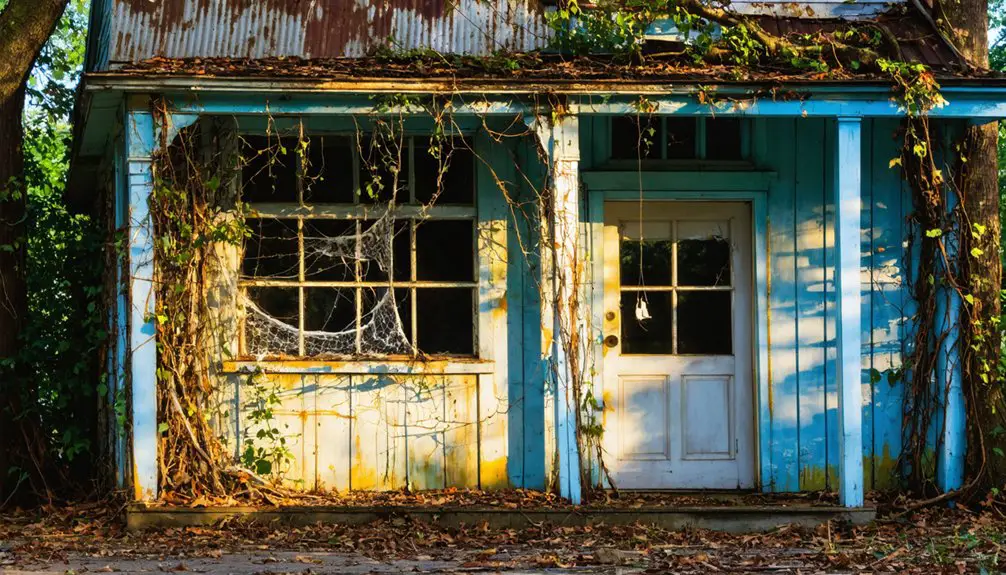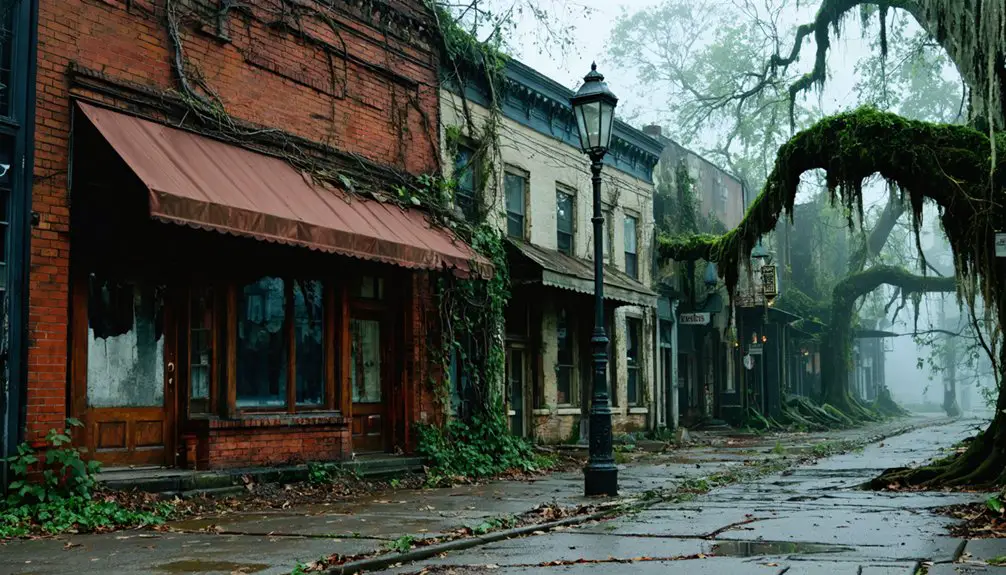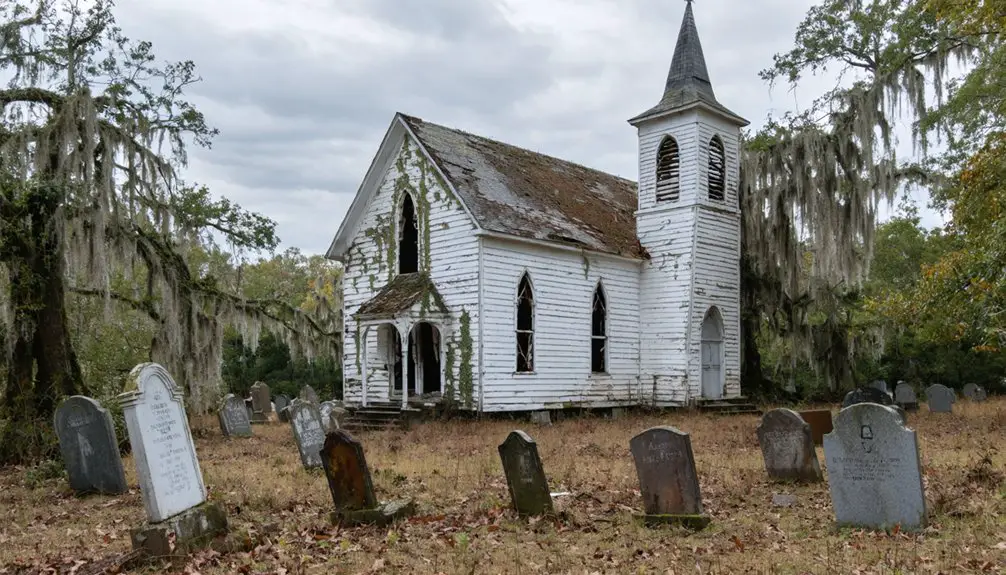You’ll find Hamburg’s ghost town site along the Savannah River across from Augusta, Georgia. Founded in 1821 as a cotton trading powerhouse, this bustling port handled 60,000 cotton bales annually worth $2 million. After the Civil War, freed slaves built a thriving self-governed community here until racial violence erupted in the tragic 1876 Hamburg Massacre. The empty riverbank now holds stories of remarkable prosperity, resilience, and devastating loss.
Key Takeaways
- Hamburg became a ghost town after economic decline caused by Augusta’s canal construction and the South Carolina Railroad’s bypass in 1848.
- Originally a thriving cotton trading hub handling 60,000 bales annually, Hamburg lost its commercial significance due to competition with Augusta.
- The Hamburg Massacre of 1876 accelerated the town’s abandonment as racial violence drove many residents away from the area.
- Natural disasters, including floods from the Savannah River, contributed to the physical deterioration of Hamburg’s remaining structures.
- Today, Hamburg’s original location lies beneath the waters of the Savannah River, submerged during twentieth-century dam construction projects.
The Rise of a Thriving River Port Town
While Augusta, Georgia, was already a prominent trading post in the early 1800s, German-born businessman Henry Shultz saw an opportunity to establish a rival port across the Savannah River. In 1821, he founded Hamburg, South Carolina, strategically positioning it to intercept commercial traffic and challenge Augusta’s dominance.
You’ll find Hamburg was perfectly situated for river navigation, with three freshwater springs and excellent access to waterborne trade routes. The town’s location proved ideal for merchants, especially after 1833 when the South Carolina Canal and Rail Road Company completed its 136-mile line to Hamburg – the world’s longest railroad at the time. Like its namesake city in Germany that earned the status of Free Imperial City in 1189, this new Hamburg aimed to establish itself as a vital trading hub.
This combination of rail and river transport transformed the settlement into one of South Carolina’s primary interior markets, where cotton and tobacco merchants thrived in fierce commercial competition with Augusta. The town’s prosperity began to wane when the rail line was extended into Augusta in 1853, diminishing Hamburg’s role as a crucial transport hub.
From Cotton Trade Hub to Economic Decline
Hamburg’s economic fortunes rode high on the cotton trade, with the town handling an impressive 60,000 bales annually – worth about $2 million in period currency.
At its peak, Hamburg became a cotton trading powerhouse, moving 60,000 bales yearly worth $2 million.
You’d find a bustling marketplace where slave traders capitalized on South Carolina’s strategic location just outside Georgia’s borders, circumventing that state’s restrictions on interstate slave commerce. The increased demand for slaves intensified as cotton profits soared in the early 1800s. Similar to its German namesake which was granted special trading rights by Emperor Frederick I in 1189, Hamburg, South Carolina established itself as a significant trading post.
But you’ll see how this prosperity didn’t last. The economic shift began when Augusta built its canal in 1848, stealing Hamburg’s river traffic.
Then came the fatal blow – the South Carolina Railroad extended into Augusta, bypassing Hamburg entirely. The town’s trade competition with Augusta proved devastating, and Hamburg’s cotton business dwindled to a fraction of its former glory.
A New Community Emerges After the Civil War
After the Civil War’s devastation, you’d find a remarkable transformation taking place along the Savannah River, as freedmen established a new self-governing community in Hamburg’s abandoned streets.
Under the leadership of Prince Rivers, Samuel J. Lee, and Charles D. Hayne, freedmen governance took root in this strategically positioned town. They’d tap into the area’s natural resources, including three freshwater springs and river access, to sustain their independent community. As part of the broader changes sweeping through South Carolina, the town benefited from state-funded schools for its children.
You’d witness the emergence of organized militia units, led by veterans like Doc Adams, protecting the hard-won freedoms of Hamburg’s residents. Tragically, these militia units became targets of white conservative hostility during the volatile Reconstruction period.
Despite the rail line’s bypass, the town thrived as a center for African American political and social organization, symbolizing the promise of Reconstruction and the determination of formerly enslaved people to build their own destiny.
The Tragic Events of July 1876
In the summer of 1876, mounting racial tensions in Hamburg would erupt into one of South Carolina’s most horrific acts of violence. A militia confrontation between armed white men and the local black militia transformed this small riverside town into a battleground.
You’ll find that the tragic sequence of events unfolded in stark detail:
- White Democrats demanded the black militia surrender their weapons, which they bravely refused to do.
- Over 100 armed whites from surrounding counties descended on Hamburg, sparking violent clashes.
- After capturing 25-30 black militia members, whites formed a “Dead Ring” for executions.
- Six African Americans were murdered, yet none of the 94 indicted whites faced prosecution.
This devastating massacre marked a turning point, suppressing black political participation and cementing white Democratic control in South Carolina. The violence was orchestrated by organized white rifle clubs that had formed across the state to intimidate Republican voters. The incident began on Independence Day when two white slaveholders confronted the Hamburg National Guard, setting off the chain of events that led to the massacre.
Remnants and Historical Significance Today
Today, you’ll find precious few remnants of what was once South Carolina’s largest inland river port. Just four landmarks remain within Hamburg’s original footprint, with nature reclaiming most of the abandoned townsite.
Archaeological discoveries have revealed glimpses of daily life – from old light switches to children’s toys hidden in decaying structures. Henry Shulz established Hamburg by building the first toll bridge across the Savannah River in 1814. A complete railroad station, including a locomotive built in 1914 and passenger car, stands as a testament to the town’s transportation history.
While the town’s physical presence has largely vanished, its historical significance endures. Memorialization efforts include markers commemorating Hamburg’s role as a crucial cotton trading hub and later as a significant Freedmen’s community.
The site, now part of North Augusta, tells a compelling story of economic boom and bust, from its 1821 founding through its final abandonment in 1929.
Though accessing these historical spots can be challenging, they’re silent witnesses to an important chapter in South Carolina’s past.
Frequently Asked Questions
What Happened to Henry Shultz, the Founder, After Hamburg’s Decline?
You’ll find Henry Shultz’s later life was spent quietly in Hamburg until his death in 1851, before the town’s major decline. Shultz’s legacy endured through the town he founded, despite mixed fortunes.
Were There Any Schools or Churches Established in Hamburg’s African American Community?
You’ll find Providence Baptist Church was central to African American education and political life there, serving as a cornerstone institution that survived even after the 1929 flood by relocating to Carrsville.
What Natural Disasters or Floods Affected Hamburg During Its Existence?
Like waves crashing on destiny’s shore, you’ll find Hamburg’s story shaped by devastating floods, particularly the 1911 Savannah River flood and two major floods in 1929. No significant hurricane impact was recorded.
Did Any Famous People Besides Prince Rivers and Ben Tillman Visit Hamburg?
Historical records don’t show famous visitors to Hamburg beyond Prince Rivers and Ben Tillman’s influence. You’ll find mostly local leaders and regional political figures maintained historical connections with the town.
How Many Buildings From the Original Hamburg Settlement Still Exist Today?
Like whispers from the past, you won’t find intact original buildings today. Despite historic preservation attempts, only scattered brick ruins and foundations remain, where some claim ghost sightings echo Hamburg’s forgotten stories.
References
- https://en.wikipedia.org/wiki/Hamburg
- https://kids.kiddle.co/Hamburg
- https://www.sciway.net/sc-history/hamburg-history.html
- https://www.randomconnections.com/hamburg-and-the-atomic-towns-part-one/
- https://csidixie.org/chronicles/hamburg-massacre
- https://www.scpictureproject.org/aiken-county/hamburg-depot.html
- https://www.scpictureproject.org/aiken-county/the-hamburg-massacre.html
- https://www.scseagrant.org/rise-and-fall-and-rise-south-carolinas-maritime-history/
- https://archive.oah.org/special-issues/teaching/2008_06/ex2.html
- https://www.scencyclopedia.org/sce/entries/hamburg-massacre/



